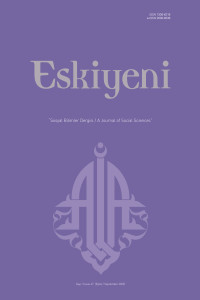Öz
Bilimsel makalelerin alan uzmanlarınca yayımlanmadan önce incelenmesini ifade eden hakem değerlendirmesi, 20. yüzyılda yaygınlık kazandı. Bu uygulama, makalelerin kalitesini değerlendirmek için önemli ve gereklidir. Türkiye merkezli yayın yapan Eskiyeni dergisi Mart 2022'de hakem raporlarını tüm okurların kullanımına sunmaya karar verdi. “Şeffaf Hakemlik” olarak bilinen bu modelde hakem raporları, yazarların yanıtları ve editör kararlarının tümü, makale ile birlikte yayımlanmaktadır. Şeffaf hakem değerlendirmesi, daha fazla hesap verebilirlik anlamına gelir. Hakem süreci sahtekarlığı, önyargı ve sonuçların manipülasyonu ihtimali bu modelde daha azdır. Eskiyeni dergisinde Mart 2022 tarihinden itibaren görev alacak hakemlere, hakem raporlarının makalelerle birlikte hakem isimleri kapatılarak yayımlanacağı bildirilmiştir. Bu uygulama, makale değerlendirme sürecinde şeffaflığı sağlayacaktır. Böylece yazarlar ve okurlar, makalenin hangi değerlendirme ve işlemlerden sonra yayımlandığını görebilecektir. Ayrıca bu uygulama ilk defa makale yayımlamayı düşünen araştırmacılara hakem sürecinin nasıl işlediği konusunda bilgilenme imkânı sunacaktır. Eskiyeni dergisi, gönderilen makalelerin değerlendirilmesinde editöryal iç inceleme ve dış hakem değerlendirmesi olmak üzere iki aşamalı bir süreç işletmektedir. Gönderim yapıldıktan hemen sonra Baş Editör, makaleyi derginin amaç ve kapsamına uygunluk ile araştırma ve yazımda etik standartlara bağlılık açısından kontrol eder. Sonrasında dergi yayın politikasına uygun makaleleri, editöryal inceleme için Editör Yardımcısı’na yönlendirir. İlk iç hakem, Yardımcı Editörler arasından seçilir. Editör Yardımcısı, makaleyi dergi yazım kurallarına uygunluk açısından inceler ve makaleyi intihal tespiti için Turnitin taramasına tabi tutar. Bu süreçte iç hakemin kimliği yazara, yazarın kimliği de hakeme açıktır. Sonrasında diğer iki iç hakem, Yayın Kurulu üyeleri arasından seçilir. İç hakemler, makaleyi konu, yöntem ve sonuçları açısından değerlendirerek ayrıntılı değerlendirme sürecine alınıp alınmamasına karar verirler. Dış değerlendirme aşamasında, Alan Editörü tarafından makalenin konusuna dair araştırması bulunan uzmanlar arasından iki dış hakem seçilir. Makale konusunda çalışması bulunan uzman bulunamazsa, hakemler o bilim dalında doktora derecesine sahip araştırmacılar arasından belirlenir. Hakemler konusu, yöntemi ve sonuçları açısından makaleyi ayrıntılı bir şekilde değerlendirerek yayımlanıp yayınlanmamasına dair görüş belirtirler. Hakem raporlarının ikisi de olumlu ise çalışma, Baş Editörün kararı ile yayıma kabul edilir. İki hakemden birinin olumsuz kanaat belirmesi halinde çalışma, üçüncü bir hakeme gönderilir. Çalışmalar, en az iki hakemin olumlu kararı ile yayıma kabul edilir. Yayıma kabul edilen çalışma Baş Editör tarafından son kez okunur. Akabinde İngilizce dil kontrolüne gönderilir. Yayına hazır olan makaleler, hakem raporları ile birlikte yayımlanır. Şeffaf hakemlik modeli, tek ve çift kör hakemlik modelleri kullanan dergiler için tamamen uygundur.
Anahtar Kelimeler
Akademik Yayıncılık Hakem Süreci Çift Taraflı Kör Hakemlik Şeffaf Hakem Modeli Eskiyeni
Öz
Peer review, which refers to the review of manuscripts by field experts in the field before they are published, became a mainstream practice in the 20th century. Peer review is a necessary practice to evaluate the quality of scientific articles. Eskiyeni decided to publish the reviewer reports, and author responses to these reports, alongside the article to all readers in March 2022. This practice is known as “transparent peer review,” TPR for short. With the TPR, peer the reviewers' reports, the authors' responses, and the editors' decision letters are all published, alongside the article. The TPR implies greater accountability while less opportunity for review fraud, bias, or manipulation of results. As of March 2022, all reviewers were informed that their reports will be published alongside the article, without disclosing their identities. This practice will help promote transparency in the peer review process. Thus, the author and readers will be able to see the evaluation process the article went through until it was published. In addition, this practice will inform researchers planning to publish an article for the first time about how the refereeing process works. Eskiyeni operates a two-stage process in the review of submitted manuscripts: the Internal editorial review and the external review process. Immediately after submission, the editor checks the manuscript to check if it fits the journal's purpose and scope and adheres to principles of ethical research and writing standards. Afterward, the editor sends the manuscripts that complies with the journal's publication policy to the assistant editor for editorial review. At this stage, three internal reviewers take charge. The editor selects one of the assistant editors as the first internal reviewer. The assistant editor examines the manuscript for compliance with the journal writing rules and checks the manuscript for plagiarism through Turnitin. During this process, the reviewers' identity is visible to the author and vice versa. The assistant editor determines the other two internal reviewers from the members of the editorial board based on their field of expertise. Internal reviewers evaluate the manuscript in terms of its subject, method, and results and decide whether it should be sent to external review for detailed evaluation. The external review is double-blind review; that is, the author and the reviewers do not know each other. The section editor selects two external reviewers among researchers who have carried out research on the manuscript’s topic. The reviewers evaluate the article in detail in terms of its subject, method, and results and write their recommendations about whether the paper should be published or not. If both reviewers' reports are positive, the study is accepted for publication with the decision of the editor. Manuscripts can be published with the positive decision of at least two reviewers. The editor rereads the manuscript accepted for publication. It is then submitted to the language editor for English editing. Finally, the peer reviewers’ reports, authors’ responses, and editors’ decision letters are all published, alongside the accepted articles. This process is fully compatible with journals using single or double anonymized review.
Anahtar Kelimeler
Academic Publishing Peer Review Process Double Anonymized Transparent Peer Review Eskiyeni
Ayrıntılar
| Birincil Dil | Türkçe |
|---|---|
| Bölüm | Editörden |
| Yazarlar | |
| Yayımlanma Tarihi | 25 Eylül 2022 |
| Gönderilme Tarihi | 1 Eylül 2022 |
| Yayımlandığı Sayı | Yıl 2022 Sayı: 47 |


